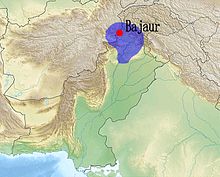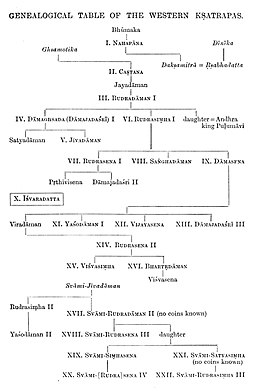
The Indo-Scythians were a group of nomadic people of Iranic Scythian origin who migrated from Central Asia southward into the northwestern Indian subcontinent: the present-day South Asian regions of Afghanistan, Pakistan and northern India. The migrations persisted from the middle of the second century BCE to the fourth century CE.

The Mathura lion capital is an Indo-Scythian sandstone capital from Mathura in Northern India, dated to the first decade of the 1st century CE. It was consecrated under the rule of Rajuvula, one of the Northern Satraps of the region of Mathura.
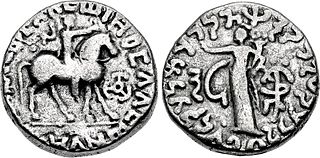
Kharahostes or Kharaosta was an Indo-Scythian ruler in the northern Indian subcontinent around 10 BCE – 10 CE. He is known from his coins, often in the name of Azes II, and possibly from an inscription on the Mathura lion capital, although another satrap Kharaostes has been discovered in Mathura.

The Shaka era is a historical Hindu calendar era, the epoch of which corresponds to Julian year 78.
The Western Satraps, or Western Kshatrapas were Indo-Scythian (Saka) rulers of the western and central parts of India, between 35 and 415 CE. The Western Satraps were contemporaneous with the Kushans who ruled the northern part of the Indian subcontinent, and were possibly vassals of the Kushans. They were also contemporaneous with the Satavahana (Andhra) who ruled in Central India. They are called "Western Satraps" in modern historiography in order to differentiate them from the "Northern Satraps", who ruled in Punjab and Mathura until the 2nd century CE.

Rudradāman I was a Śaka ruler from the Western Kshatrapas dynasty. He was the grandson of the king Caṣṭana. Rudradāman I was instrumental in the decline of the Sātavāhana Empire. Rudradāman I took up the title of Maha-kshtrapa, after he became the king and then strengthened his kingdom.

Chashtana was a ruler of the Saka Western Satraps in northwestern India during 78-130 CE, when he was the satrap of Ujjain.

Rudrasimha III was the last ruler of the Western Satraps in India, in the 4th century AD. Rudrasimha III succeeded Rudrasena IV as the leader of the Indo-Scythians in India. Both were the sons of the Saka ruler Satyasimha, making them at least half-brothers, if not first-degree relatives.
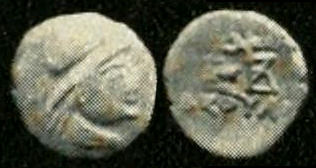
Liaka Kusulaka was an Indo-Scythian satrap of the area of Chukhsa in northwestern India during the 1st century BCE.

Jivadaman was a Saka ruler of the Western Kshatrapas in northwestern India from during the 2nd century CE. He was the son of Damajadasri I (170–175), and the brother of Satyadaman.

Rudrasimha I was a Western Kshatrapa ruler, who reigned from 178 to 197 CE. He was son of Rudradaman I, grandson of Jayadaman, and grand-grandson of Chashtana. During his reign, the Abhiras became increasingly important. Some of them were even serving as generals. Ashvini Agrawal thinks that the Abhira king Isvardatta was a general in the service of Rudrasimha I who deposed his master in 188 A.D and ascended the throne. Ashvini Agrawal further says that Rudrasimha I soon deposed him and regained the throne in 190 A.D.

Rudrasena II (256–278) was a king of the Western Satraps, and the 19th ruler of the Kshatrapa dynasty. The Kshatrapa dynasty seems to have reached a high level of prosperity under his rule.

The Kanakerha inscription, also spelled Kanakherha inscription, is an inscription found on the side of the hill of Sanchi, dating to the 3rd or 4th century CE.

Rudrasimha II (304–348) was a ruler of the Western Satraps He declared on his coins to be the son of a Lord (Svami) named Jivadaman.

Yasodhaman II (317–332) was a son and probably sub-king of king Rudrasimha II of the Western Satraps. He declared on his coins to be the son of Rudrasimha II.

Viśvasena was a ruler of the Western Satraps, and the 22nd ruler of the Kshatrapa dynasty. He was the last Kshatrapa ruler of the Chastana family, brother and successor to Bhartrdaman and son of Rudrasena II.

Sridharavarman was a Saka (Indo-Scythian) ruler of Central India, around the areas of Vidisa, Sanchi and Eran in the 4th century CE, just before the Gupta Empire expansion in these areas. He calls himself a general and "righteous conqueror" in an inscription, and Rajan ('King') and Mahaksatrapa in a probably later inscription at Eran, suggesting that he may have been a high-ranked officer who later rose to the rank of a King.
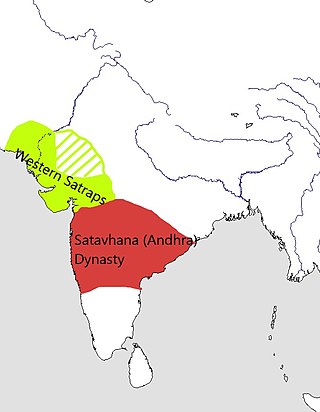
The Saka-Satavahana Wars were a series of conflicts fought between the Saka ksatraps and the Satavahanas during the 1st-2nd century CE. Both sides achieved success at varying points during the conflicts, but in the end, it was the Satvahanas which prevailed. However, constant wars with the Sakas severely weakened them and was a major contributor in their fall.

The Gupta-Saka Wars refers to the military conflict between the Gupta Empire, ruled by Chandragupta II, and the Western shatrapas, also known as the Shakas, during the 4th century CE.



